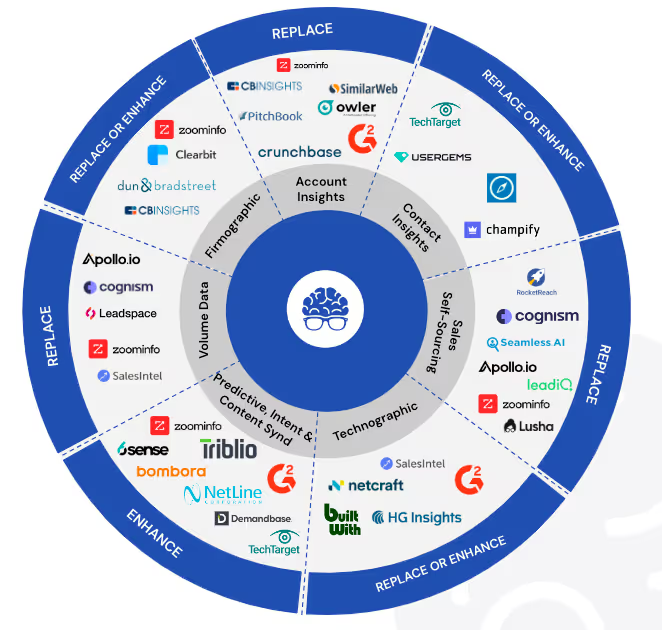In July, Clay announced a massive $100 million funding round led by CapitalG (Alphabet’s growth fund), tripling its valuation and setting off a frenzy in the GTM tech world. But if you think this raise was about becoming the next great data platform, think again.
Clay didn’t raise on the back of data quality or cost efficiency. It raised because it’s becoming a workflow and automation marketplace — a flexible orchestration layer for outbound, enrichment, and AI-augmented GTM plays.
And that’s both the brilliance and the problem.
Clay Is a Great Marketplace. It’s Just Not a Great Workflow Tool.
Clay has built a fanatical user base by opening up APIs, integrations, and access to hundreds of data providers. Their power users love the flexibility. “Claygencies” — agencies built entirely on Clay workflows — have popped up everywhere. User communities are forming. And yes, their revenue has reportedly tripled in the last year, hitting $100M.
But let’s pause there. That revenue isn’t recurring platform spend. A huge chunk is passed through to third-party data providers in the form of credit waterfalls. In other words, Clay is a layer on top of other data sources — a switchboard, not a signal generator.
And when it comes to workflows? There are better options.
What GTM Teams Really Need
GTM leaders aren’t short on tools — they’re drowning in them. In a world where every platform promises the moon, we’ve traded simplicity for dashboards and strategy for subscription bloat. Clay offers power, yes. But that power comes with complexity:
- You need a part-time Clay engineer just to manage integrations and workflows.
- You need to manage dozens of data vendors, each with different pricing structures.
- You pay in credits, not outcomes.
We’ve talked to dozens of growth leaders who hit a wall. They start with a promise of flexible enrichment and end up neck-deep in configuration hell. And by the time they've burned through their credits? The data's stale, the workflows are brittle, and the ROI is murky at best.
Workflow Shouldn’t Be the Bottleneck
Tools like n8n, Make, and Zapier already provide world-class, open-source, or low-cost automation. Want to scrape, enrich, send, and log to a CRM? n8n will do it — often faster and with better visibility. Want to plug in LLMs, build in decision trees, and trigger campaigns? You’re not locked into one marketplace’s preferred vendors.
Clay’s bet is that a verticalized, all-in-one GTM automation platform will beat out the duct-taped, Frankensteined stack. But here’s the thing: modular is winning again. Especially when your team needs clarity, not another black box.
The Real Cost of Clay
Let’s break it down:
- Credit pricing means data costs fluctuate wildly (a mobile number might cost 2 credits or 25 — you won’t know until it hits your bill).
- Pass-through data means you’re not building durable value — you’re renting access.
- Workflow complexity means you need headcount just to manage the stack.
Now layer on new “Signals” features, video call scraping, and sales ticket scanning. These aren’t bad ideas — but they move the product further away from usable and toward bloated.
Clay isn’t selling simplicity anymore. It’s selling extensibility. That works for a certain kind of team, but not for the majority of GTM orgs just trying to hit quota with better leads.
There’s a Better Way: Enrich Smarter, Not Louder
At LeadGenius, we take a different approach. We’re not trying to be your Swiss Army knife. We’re trying to be your precision scalpel — delivering custom data, on demand, without requiring an operator’s manual.
Here’s what that looks like:
- Flat pricing and no credit games.
- On-demand enrichment that scales with your motion.
- Signals that matter, like hiring trends, tech adoption, funding, location expansion, and more — not just email open rates or Slack-channel sentiment.
- Zero black boxes. We integrate cleanly with your CRM and workflows, or build them with you.
We’re not saying Clay is bad. It’s just not what most GTM teams need it to be — not without overhead.
TL;DR
Clay raised $100M to become a GTM automation marketplace — not because it's the best source of data, but because it’s a flexible connector of other tools.
That’s fine, if you have the time, talent, and budget to build on top of it. But for GTM leaders focused on repeatable pipeline, better conversion rates, and lower CAC, the signal-to-noise ratio matters more than the buzz.
The future isn’t “more tools.” It’s smarter signals and simpler execution.
And that’s exactly what we’re building at LeadGenius.
Want to see how LeadGenius stacks up against Clay?Get a side-by-side comparison of workflows, costs, and outcomes — or run a test campaign to prove the difference.[Book a free consult →]




